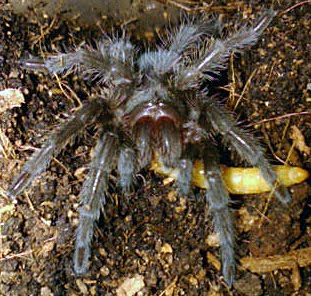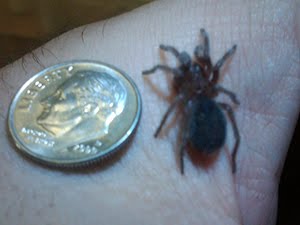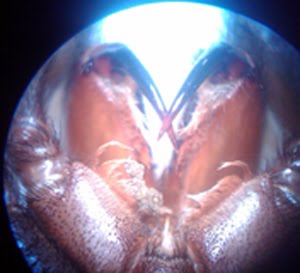On September 22 both Shadow(003) and Eclipse(001) molted. On September 28 Phantom(002) molted. Shadow and Eclipse were confirmed female, and Phantom confirmed through examination of the exuviums. Now if Midnight would quit being a stage monger, perhaps he will molt soon.
The back story:
When I entered the classroom on Wednesday, September 22, I went to check on the tarantulas, as I always do, and noticed something very disturbing. I grabbed my stool and stepped up to get a closer look. Eclipse was in the far rear corner of her enclosure in what looked to be a tangled mess. My immediate thought was "Oh no!, She is in a death curl! What happened!" I peered in for a closer look and noticed a few extra legs. *deep sigh* "She is molting." I carefully opened her enclosure, and sure enough she had just completed her molt and was still lying in her back. She had spun a silk hammock over the entrance to her burrow and used it as her molt mat. Thinking she was clear of her exuvium I grabbed my forceps and carefully grasped the exuvium and began to pull it out. Unknown to me, she was still lying on it; as I tugged she flipped over. Fortunately she was not harmed, and I got a perfect exuvium specimen. The exuvium had no tears in at all, and upon closer examination under the microscope I could could see distinct spermathecae. I have prepared her exuvium to be mounted for display.
I went back to the shelf and checked on the other three and found that Shadow has also completed a molt inside her burrow. She looked to have finished her molt a few hours before Eclipse did. Six days later, Phantom joined the group. Eclipse and Phantom have not yet exited their burrows, so I have not been able to get their exuviums out for examination.
They should all be well over 4" after this molt. This should put the myth about G. pulchra being a slooow grower to rest. I received these four back in December 2009 at just over 1" (they were alittle larger than the diameter as a quarter. Now, nine months later they are over 4". Their molt progression has slowed over the nine months time. In the beginning they were molting about once a month, and now they are molting about every two months. It will be intersting to see how long it will be to the next molt.
 |
| Eclipse(001) exuvium is clearly 3.5"+ |
 |
| Eclipse right after the flip |
 |
| Eclipse, wishing the paparazzi would go away |
 |
| Phantom's exuvium, nearly 4", if the front leg were extended |



















